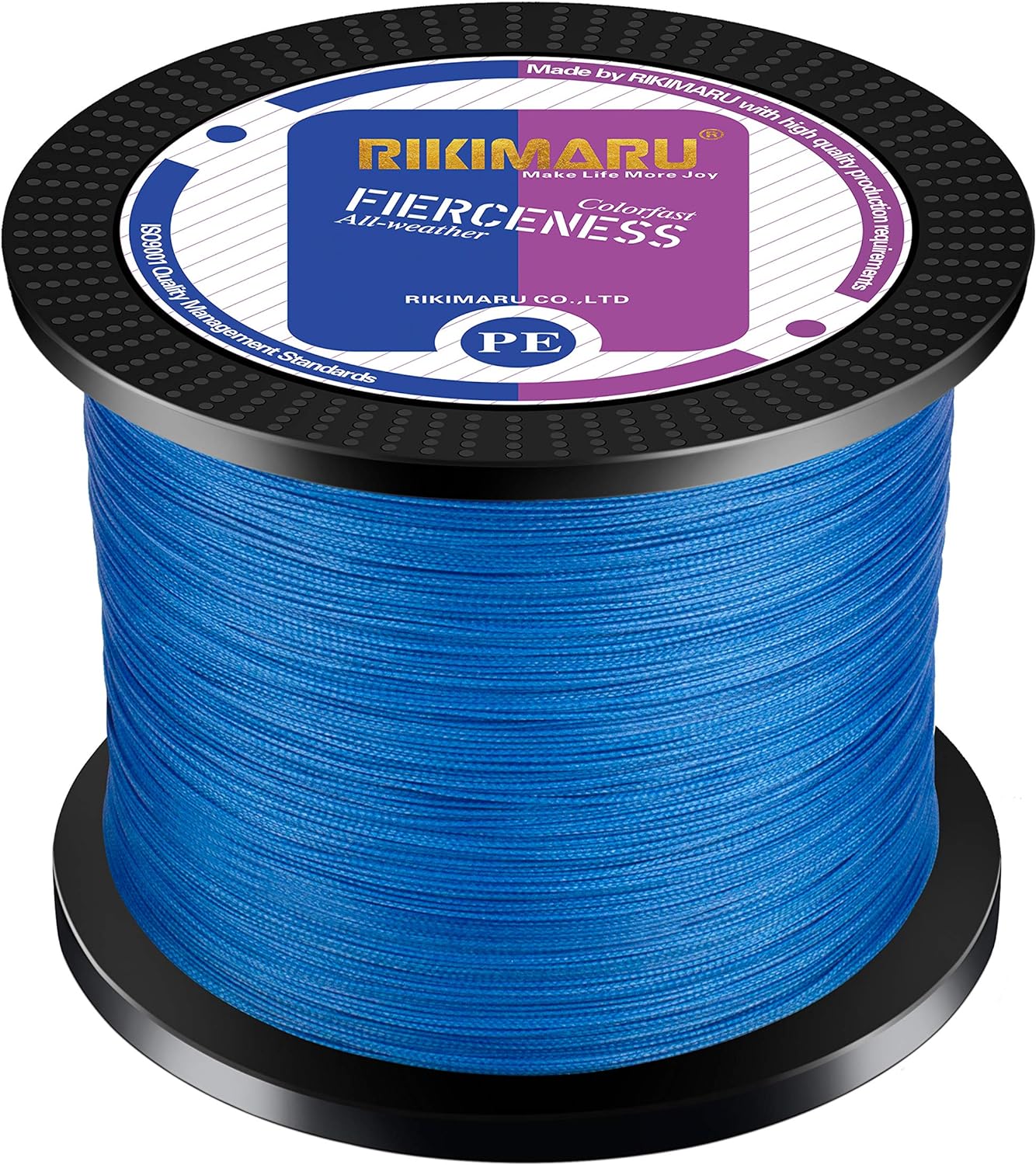Introduction:
In the realm of angling, selecting the right fishing line can significantly impact one’s success on the water. Among the myriad options available, braided fishing line stands out as a versatile and reliable choice for anglers across various fishing disciplines.
Understanding when to utilize braided line amidst the array of fishing lines is crucial for optimizing fishing performance in diverse angling scenarios.
 Braided fishing line, often crafted from synthetic fibers like Spectra or Dyneema, offers a distinct set of advantages over monofilament and fluorocarbon lines. Its inherent strength, minimal stretch, and enhanced sensitivity make it particularly well-suited for certain fishing techniques and conditions.
Braided fishing line, often crafted from synthetic fibers like Spectra or Dyneema, offers a distinct set of advantages over monofilament and fluorocarbon lines. Its inherent strength, minimal stretch, and enhanced sensitivity make it particularly well-suited for certain fishing techniques and conditions.
However, discerning the optimal circumstances for deploying braided line requires a nuanced understanding of its properties and practical applications.
Throughout this guide, we’ll delve into the nuanced considerations that dictate when braided fishing line proves most advantageous.
From exploring its superior strength-to-diameter ratio to delving into its low stretch properties, we’ll unravel the scenarios where braided line excels, providing anglers with the knowledge needed to make informed decisions on the water.
Whether casting for bass in heavy cover or battling saltwater behemoths offshore, mastering the art of utilizing braided fishing line can undoubtedly elevate an angler’s prowess and enjoyment of the sport.
The Strength Advantage
Braided fishing line boasts unparalleled strength relative to its diameter, making it a go-to choice for anglers seeking robustness without sacrificing sensitivity. Unlike monofilament lines, which can weaken over time due to exposure to sunlight and abrasion, braided line maintains its tensile strength even in the harshest conditions.
This durability makes it ideal for targeting hard-fighting species or fishing in rugged environments where abrasion resistance is paramount.
One of the primary benefits of braided line is its exceptional knot strength. Due to its construction from multiple strands tightly woven together, braided line exhibits minimal knot slippage, ensuring that connections between line, leader, and terminal tackle remain secure even during prolonged battles with powerful fish. This reliability instills confidence in anglers, allowing them to tackle formidable adversaries with assurance.
Moreover, braided line’s thin diameter relative to its strength enables anglers to spool more line onto their reels, increasing casting distance and maximizing depth potential. This extended reach proves invaluable when targeting elusive fish holding in deep water or when precision casting to structure-rich environments where accuracy is key.
In addition to its robustness, braided line’s minimal stretch properties offer distinct advantages during hooksets and fish fights. Unlike monofilament lines, which can stretch significantly under pressure, braided line transmits even the subtlest of bites and provide immediate hook penetration upon setting.
This responsiveness is particularly advantageous in scenarios where quick reflexes are essential, such as finesse fishing or targeting fast-moving species.
Furthermore, the low stretch of braided line enables anglers to exert greater control over hooked fish, minimizing the risk of fish throwing the hook or becoming entangled in structure.
Whether hauling bass out of dense vegetation or battling trophy-sized gamefish in open water, the direct connection afforded by braided line enhances an angler’s ability to maneuver and land fish efficiently.
Despite its numerous strengths, braided line is not without its limitations. Its high visibility can be a drawback in clear water conditions, where wary fish may shy away from conspicuous lines.
To mitigate this issue, anglers often incorporate fluorocarbon or monofilament leaders to provide stealth and camouflage while maintaining the superior strength and sensitivity of braided mainline.
Practical Applications
Braided fishing line finds application across a wide spectrum of angling scenarios, thanks to its versatility and performance-enhancing properties. Understanding the practical applications of braided line is essential for anglers looking to optimize their fishing experience and achieve success on the water. Below is a comprehensive list of situations where braided fishing line excels:
- Heavy Cover Fishing: When targeting fish hiding in dense vegetation, submerged brush, or other forms of heavy cover, braided line shines. Its superior strength and abrasion resistance allow anglers to haul fish out of thick cover without fear of line breakage.
- Pitching and Flipping: Braided line’s low stretch and high sensitivity make it ideal for pitching and flipping techniques, where precise lure placement and instant hooksets are critical. Anglers can feel even the slightest bites and quickly respond with decisive hooksets.
- Topwater Fishing: When fishing with topwater lures, braided line’s buoyancy and minimal stretch properties are advantageous. Anglers can impart action to their lures more effectively and achieve better hook penetration when fish strike.
- Deep Water Fishing: Braided line’s thin diameter relative to its strength enables anglers to spool more line onto their reels, facilitating long casts and deep water presentations. This extended reach is invaluable when targeting fish holding in deeper offshore structures.
- Vertical Jigging: Whether jigging for walleye, bass, or other species, braided line offers excellent sensitivity and responsiveness to subtle strikes. Anglers can detect bites more easily and maintain better contact with their lures throughout the jigging motion.
- Trolling: Braided line’s durability and low stretch properties make it well-suited for trolling applications. Anglers can confidently troll large baits or lures at high speeds without worrying about line failure or loss of sensitivity.
- Saltwater Fishing: In saltwater environments where fish species are often larger and more powerful, braided line’s strength and abrasion resistance are indispensable. Whether battling trophy-sized gamefish or navigating through rocky structures, braided line provides the durability needed to land saltwater species successfully.
- Ice Fishing: Braided line’s sensitivity and low memory make it an excellent choice for ice fishing, where detecting subtle bites is crucial. Its thin diameter allows anglers to fish with lighter presentations while still maintaining the strength to handle hard-fighting fish.
Considerations for Effective Use
While braided fishing line offers numerous benefits, its effective use requires careful consideration of several factors to maximize performance and mitigate potential drawbacks. Anglers should be mindful of the following considerations when utilizing braided line:
- Line Visibility: Braided fishing line tends to be highly visible in the water, which can spook wary fish in clear conditions. To minimize visibility, consider using a fluorocarbon or monofilament leader, especially when fishing in crystal-clear waters or targeting finicky species like trout.
- Knot Strength: While braided line exhibits excellent knot strength, certain knots may perform better than others. Opt for knots specifically designed for use with braided line, such as the Palomar knot or the improved clinch knot, to ensure maximum knot security and reliability.
- Line Management: Braided line has minimal stretch and can be prone to backlash and tangles, especially on baitcasting reels. Proper line management techniques, such as thumb pressure control during casts and adjusting spool tension settings, can help prevent these issues and improve casting efficiency.
- Abrasion Resistance: Despite its durability, braided line may fray or weaken when rubbed against sharp edges or abrasive surfaces. Avoid fishing in areas with jagged rocks or submerged debris, or consider using a fluorocarbon or monofilament leader to provide additional abrasion resistance.
- Hooksets: Due to its low stretch properties, braided line requires a different hookset technique compared to monofilament or fluorocarbon lines. Instead of a sweeping hookset motion, utilize a firm, direct hookset to ensure immediate penetration and secure hookups.
- Maintenance: Regularly inspect your braided line for signs of wear, fraying, or damage, especially after fishing in rough conditions or tangling with hard-fighting fish. Replace any compromised sections of line to prevent potential line failure during future outings.
- Environmental Impact: Unlike monofilament lines, braided fishing line is not biodegradable and can persist in the environment for years if improperly discarded. Dispose of used line responsibly by recycling it at designated collection points or disposing of it in specialized recycling bins.
Comparing Braided Line to Other Types
When selecting the most suitable fishing line for a particular angling scenario, anglers often weigh the merits of braided line against other types such as monofilament and fluorocarbon.
Each type of line offers distinct advantages and drawbacks, and understanding the differences can help anglers make informed decisions. Below is a comparison highlighting the key characteristics of braided line in contrast to monofilament and fluorocarbon lines:
| Characteristic | Braided Line | Monofilament Line | Fluorocarbon Line |
| Strength | Exceptionally strong with minimal diameter | Moderate strength with thicker diameter | High strength with similar diameter to monofilament |
| Stretch | Minimal stretch, offering superior sensitivity | Moderate stretch, providing forgiveness on hooksets | Low stretch, similar to braided line |
| Visibility | Highly visible due to its color and lack of translucency | Low visibility underwater | Virtually invisible underwater, similar to water’s refraction |
| Abrasion Resistance | Excellent resistance to abrasion and sharp edges | Moderate resistance to abrasion | High resistance to abrasion |
| Sink Rate | Buoyant and tends to float on the water’s surface | Sinks slowly due to its density | Sinks quickly, similar to monofilament line |
| Knot Strength | Strong knot strength, but certain knots may slip | Reliable knot strength with minimal slippage | Excellent knot strength with minimal slippage |
| Price | Typically more expensive than monofilament | Generally affordable, varying by brand and quality | Usually the most expensive option |
Strength: Braided line boasts exceptional strength relative to its diameter, making it the top choice for anglers seeking robustness without sacrificing sensitivity. Monofilament line offers moderate strength with a thicker diameter, while fluorocarbon line provides high strength comparable to monofilament but with a similar diameter to braided line.
Stretch: Braided line exhibits minimal stretch, offering superior sensitivity and immediate hooksets. Monofilament line has moderate stretch, providing forgiveness on hooksets and shock absorption, whereas fluorocarbon line offers low stretch similar to braided line.
Visibility: Braided line is highly visible due to its color and lack of translucency, which can be advantageous in certain scenarios but may spook wary fish in clear water. Monofilament line has low visibility underwater, while fluorocarbon line is virtually invisible underwater, mimicking the refraction of water.
Abrasion Resistance: Braided line offers excellent resistance to abrasion and sharp edges, making it suitable for fishing in rugged environments. Monofilament line provides moderate resistance to abrasion, while fluorocarbon line offers high resistance to abrasion, ideal for fishing around structure.
Tips for Spooling and Handling Braided Line
Proper spooling and handling of braided fishing line are essential to ensure optimal performance and longevity on the water. Due to its unique characteristics, braided line requires specific techniques to minimize issues such as line twist, casting problems, and knot slippage. Below are some expert tips for spooling and handling braided line effectively:
- Backing Material: Before spooling braided line onto your reel, consider using a backing material such as monofilament or electrical tape. This helps prevent slippage and ensures a secure connection between the braided line and the spool.
- Tension Control: Maintain consistent tension while spooling braided line onto your reel to prevent loose wraps and potential line twist. Use your fingers or a tensioning device to apply steady pressure as you wind the line onto the spool.
- Layering: Avoid overfilling your reel spool with braided line, as this can lead to casting problems and backlash. Leave approximately 1/8 inch of space between the line and the spool lip to prevent overfilling.
- Backing Knots: When connecting braided line to backing material or leader, use strong knots such as the double uni knot or the Albright knot. Ensure that the knots are properly seated and tightened to prevent slippage during casting and fish fighting.
- Line Management: Practice proper line management techniques to minimize tangles, knots, and backlash while casting. Keep your line taut during retrieves and be mindful of wind direction to prevent line twist.
- Knot Sealing: After tying knots with braided line, consider applying a small amount of super glue or clear nail polish to the knot to secure it and prevent slippage. This extra step can significantly increase knot strength and reliability.
- Reel Maintenance: Regularly inspect your reel for signs of wear, corrosion, or damage, particularly around the spool and line guide. Clean and lubricate your reel as needed to ensure smooth line retrieval and casting.
- Spooling Direction: Pay attention to the direction in which you spool braided line onto your reel. Most reels are designed for counter-clockwise spooling, so be sure to follow the manufacturer’s recommendations to avoid line twist and casting issues.
 I have an article for this Durable Aluminum Fishing Line Winder with a Vacuum Suction Base and Adjustable Tension if you would like more information please click here. Just note you will be leaving this page.
I have an article for this Durable Aluminum Fishing Line Winder with a Vacuum Suction Base and Adjustable Tension if you would like more information please click here. Just note you will be leaving this page.
Maintenance and Storage Guidelines
Proper maintenance and storage of braided fishing line are essential to preserve its integrity, longevity, and performance over time. Unlike monofilament or fluorocarbon lines, braided line requires specific care due to its unique composition and characteristics. Below are essential guidelines for maintaining and storing braided fishing line:
- Cleaning: After each fishing trip, carefully inspect your braided line for any signs of dirt, debris, or abrasion. Use a soft cloth or sponge dampened with mild soap and water to gently clean the line, removing any accumulated grime or residue. Avoid using harsh chemicals or abrasive cleaners, as these can weaken the line’s fibers.
- Drying: Ensure that your braided line is thoroughly dried before storing it to prevent mold, mildew, and line degradation. Lay the line out flat in a well-ventilated area away from direct sunlight and allow it to air dry completely. Avoid winding wet or damp line onto your reel, as this can promote corrosion and line deterioration.
- UV Protection: Braided line is susceptible to damage from prolonged exposure to ultraviolet (UV) radiation, which can weaken its fibers and reduce its strength over time. Store your reels and spools in a cool, dark place away from direct sunlight when not in use, or consider using line conditioner products with UV inhibitors to provide additional protection.
- Line Conditioners: Periodically treat your braided line with a high-quality line conditioner designed specifically for braided lines. These products help maintain the line’s suppleness, reduce friction, and improve casting distance and accuracy. Follow the manufacturer’s instructions carefully when applying line conditioner to ensure optimal results.
- Storage: When not in use, store your braided fishing line in a dry, climate-controlled environment to prevent exposure to moisture, humidity, and temperature fluctuations. Avoid storing line spools in areas prone to extreme heat or cold, as this can cause the line to become brittle or tacky.
- Spool Rotation: To prevent line memory and ensure even wear, periodically rotate the spools of braided line on your reels. If one section of line is consistently exposed to sunlight or friction, it may degrade more quickly than other sections. By rotating the spool periodically, you can distribute wear and prolong the lifespan of your braided line.
- Regular Inspection: Routinely inspect your braided line for signs of wear, fraying, or damage, particularly in areas prone to abrasion or stress, such as near knots or guides. Replace any compromised sections of line promptly to prevent line failure and ensure reliable performance on the water.
In conclusion, braided fishing line stands as a formidable ally in the pursuit of angling excellence, offering anglers’ unparalleled strength, sensitivity, and versatility across a wide range of fishing scenarios. Throughout this comprehensive guide, we’ve explored the myriad benefits and practical applications of braided line, from its superior strength-to-diameter ratio to its low stretch properties and buoyancy advantages.
By understanding when and how to utilize braided line effectively, anglers can elevate their fishing game to new heights, whether casting for bass in heavy cover, trolling for offshore pelagics, or finesse fishing for elusive species.
However, success with braided line requires more than just spooling it onto a reel—it demands careful consideration of factors such as line visibility, knot strength, and proper maintenance techniques to ensure optimal performance and longevity on the water.
By adhering to the guidelines outlined in this guide, anglers can harness the full potential of braided fishing line and unlock new opportunities for angling success and enjoyment.
Whether targeting freshwater or saltwater species, from the bank or a boat, braided line empowers anglers to tackle the toughest angling challenges with confidence, precision, and reliability. So, next time you embark on a fishing adventure, consider the benefits of braided line and experience the difference it can make in your angling endeavors.
Ready to experience the edge braided line offers? Find a selection of top-rated braided fishing lines on Amazon to match your needs.
Disclosure: As an Amazon Associate, I may earn a small commission from qualifying purchases at no additional cost to you. This helps support the creation of informative fishing content.




